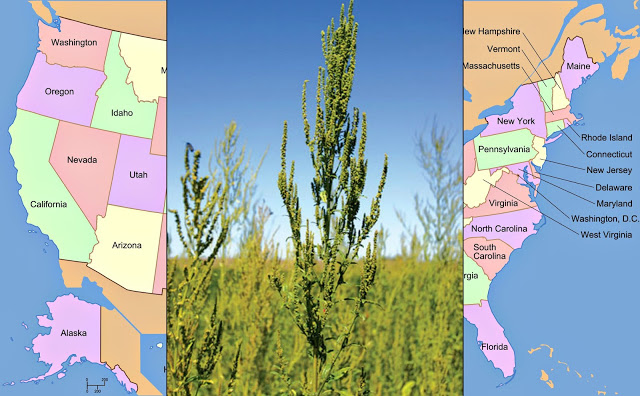Increasing American Weed Resistance: This Year’s 60-Mile Jump
Yet, even Peters wonders with incredulity about a recent Midwestern “60-mile jump” in areas of glyphosate-resistances.
“I’m looking at metolachlor, but not as a stand-alone concept,” he says. “ I’m looking at it at very low rates, as a way to buy time until farmers can get to their post-emergence (herbicide) program, or their lay-by program.”
The experiment compares various regimens: no herbicide; Roundup-ready varieties followed by glyphosate, or Roundup; various soil-applied herbicides (including metolachlor); metolachlor, followed by lay-by applications of various other herbicides.
“Roundup still controls a lot of weeds and I can see it in my plots, but for tough weeds — weeds like waterhemp — we need other programs, other strategies and we need to implement them in a timely fashion.”
 He wants more pre-emergence, soil-applied pesticide solutions. This might buy time against increasing resistance but does not “uproot” the main cause of the problem, does it? Not to mention, metolachlor is not something we need in groundwater, as it can cause chromosomal damage. Would sugar beet crops just be getting another insulin shot?
He wants more pre-emergence, soil-applied pesticide solutions. This might buy time against increasing resistance but does not “uproot” the main cause of the problem, does it? Not to mention, metolachlor is not something we need in groundwater, as it can cause chromosomal damage. Would sugar beet crops just be getting another insulin shot?
To be sure, a lot of consumers and farmers will appreciate Peters’ vigor at coming up with farming solutions for the time being. However, it is the recklessness and urgency of biotech, with the blind willingness of government agencies that first led to this ecological disaster. Conventional large-scale farming, with its emphasis on monoculture, no doubt had its issues – especially with pests and the chemical eradication of them, versus other solutions. But even that does not compare to the ever-increasing disastrous effects of genetically modified crops. Just like the waterhemp, it appeared innocent enough until its proliferation was complete.
One retired farmer in Iowa has a second career devoted to helping consult farmers who have had their crops fall over after a storm – only to discover that it was corn rootworm damage and that they too have become resistant in the last 10 years. Both he and an entomologist have recommended crop rotation as a solution. Shouldn’t we wonder why such a consulting career exists – and how much farmers will have to keep paying in order to have a crop that works?
This “challenge” or “opportunity” could have been spared, had there been legitimate, long-term safety testing, or, an actual desire to “feed the world” and help farmers.
Image source: University of Missouri
Heather Callaghan is a natural health blogger and food freedom activist. You can see her work at NaturalBlaze.com and ActivistPost.com. Like at Facebook.



